AISC
Research Updates
SpeedCore Research Updates
February 2024
New findings from SpeedCore-related research are now available. A large body of research has been completed, and there is still ongoing research for this exciting and innovative system. Find out about updates to ongoing and recently completed projects below.
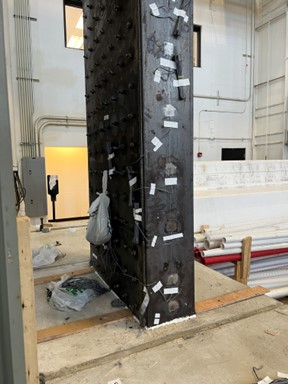
SpeedCore wall to foundation wall test
specimen. Photo courtesy of Amit Varma,
PhD.
Composite Floor-to-SpeedCore Wall Systems: Performance-Based Fire Resistance and Design
Principal investigator: Amit Varma, PhD, Purdue University
Project status: Complete
The goal of this recently completed research project is to develop an approach for performance-based fire resistance design of complete floor systems consisting of SpeedCore walls, composite floor slabs, and wall-to-floor connections. This project includes experimental and numerical analyses to gain insight into the behavior of the complete system under fire and gravity loading. The results obtained from the analyses are being used to develop design and detailing recommendations for the floor systems and associated connections under fire and gravity loading.
Elevated temperatures affect the mechanical properties of steel and concrete during a fire event in buildings and can lead to stability-related failure of structural components. The performance of SpeedCore walls under fire loading was investigated by Anvari et al. (2020). A design approach developed to design SpeedCore walls without a need for fire protection will be included in the upcoming version of the AISC Specification.
A link to the final report for this project will be available soon. This project was made possible by collaboration with the Charles Pankow Foundation (CPF Research Grant #03-20).
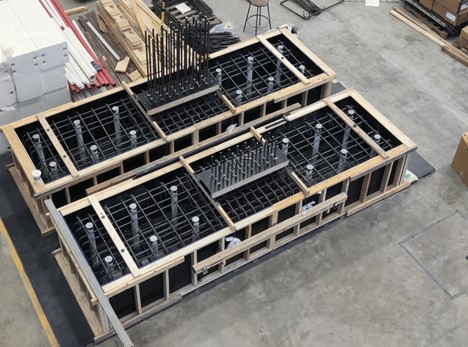
SpeedCore wall to foundation wall test specimen prior to concrete pour.
Photo courtesy of Amit Varma, PhD.
Wind and Seismic Behavior and Design of C-PSW/CF (“SpeedCore”) to Reinforced Concrete Foundation or Wall Connections
Principal investigator: Amit Varma, PhD, Purdue University
Project status: Complete
An important aspect of the commercial application of composite plate shear walls (C-PSW/CF, a.k.a., “SpeedCore”) is their connection to reinforced concrete foundations or reinforced concrete walls. SpeedCore walls are typically designed as uncoupled or coupled shear walls, and the lateral forces resisted by these walls need to be safely transferred to foundations or foundation walls.
The SpeedCore-to-reinforced concrete foundation/wall connection force transfer mechanism can often be complex due to the proportions of the lateral forces resisted by the steel plates and by the concrete infill.
This study considered experimental and numerical investigations evaluating the wind and seismic performance of SpeedCore-to-reinforced concrete foundations or walls. Three specimens, including two SpeedCore-to-reinforced concrete foundation specimens and one SpeedCore-to-reinforced concrete wall specimen, were considered in the experimental study. They were designed, constructed, and tested at Purdue’s Bowen Laboratory. The specimens were subjected to a constant axial force and in-plane lateral cyclic loading with increasing magnitudes. The lateral cyclic loading protocol included both wind and seismic loading cycles.
A link to the final report for this project will be available soon. This project was made possible by collaboration with the Charles Pankow Foundation (CPF Research Grant #06-16).
SpeedConnection Research Updates
February 2024
Three SpeedConnection projects are currently underway. These projects show promise in our efforts to increase the speed at which steel-framed buildings are constructed.
Drop-In Top Flange Connections for Increased Speed of Steel Erection
Principal investigators: Matthew Yarnold, PE, PhD, and Kadir Sener, PE, PhD, Auburn University
Project status: Expected completion in January 2025
A common connection in typical steel systems is the girder-to-column and beam-to-girder connection. Shear tab connections are popularly used, essentially bolting the web a girder to a plate that is welded to the column, or bolting the web a beam to a plate that is welded to the girder. The proposed improved design is a drop-in top flange connection in which the girder/beam is seated on the bottom of the top flange. Angles are shop welded to the column or girder, and the girder/beam is coped on the bottom flange to allow for a simple drop-in erection. The final connection is made via vertical bolts attaching the top flange of the girder/beam to the angles.
The advantages of the proposed drop-in connection design include faster erection speed due to the drop-in nature of the girder or beam, stability during erection due to the compression flange being supported prior to final bolting, and a reduction in the number of bolts required for each connection.
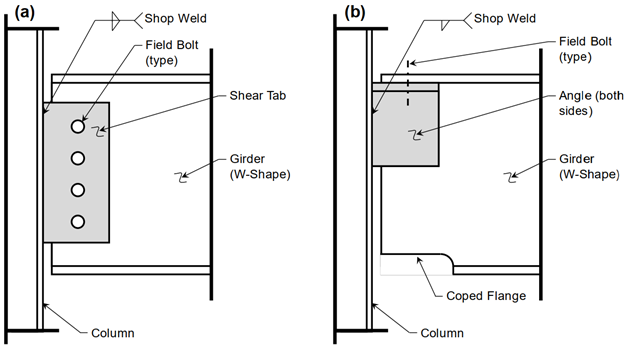
Illustration of (a) conventional shear tab, and (b) proposed drop-in connection.
Photo courtesy of Matthew Yarnold, PE, PhD, and Kadir Sener, PE, PhD.
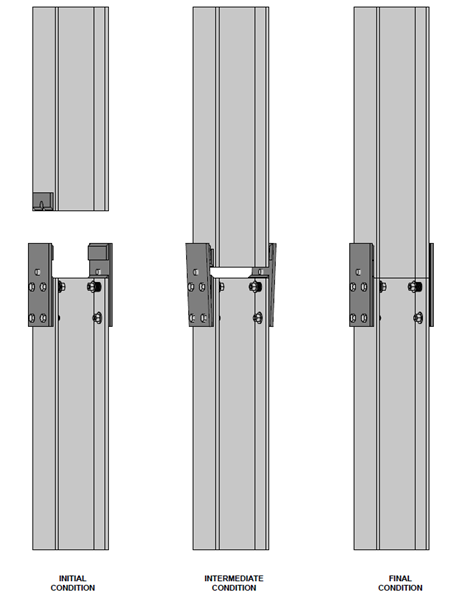
Illustration of “The SnapLocX” column splice
connection. Image courtesy of Jeff Berman, PhD,
and Dawn Lehman, PhD.
A Novel Column Splice Connection: The SnapLocX
Principal investigators: Jeff Berman, PhD, and Dawn Lehman, PhD, University of Washington
Project status: Expected completion of phase 1 in March 2024
Column splice connections typically require field bolting or welding. The SnapLocX Connection introduces a “snap and lock” operation, which saves both construction time and labor. The SnapLocX Connection uses snapping plates that are shop bolted to the lower column in a connection designed to engage two plates that are shop welded to the column above the splice. Bolts connect the lower snap plate to the lower segment of the column using a spring mechanism.
FastFloor Research Updates
February 2024
The FastFloor initiative aims to decrease both fabrication and erection time, and to bring the finished floor plate to completion in approximately half of the time as compared to a traditional concrete slab on metal deck system.
Two separate projects in the FastFloor portfolio are currently being studied: a commercial solution and a residential solution.
FastFloor Commercial Solution
Principal investigators: Jerome Hajjar, PE, PhD, Northeastern University; Benjamin Schafer, PE, PhD, Johns Hopkins University; Matthew Eatherton, SE, PhD, Virginia Tech; Onur Avci, PE, PhD, West Virginia University; W. Samuel Easterling, PE, PhD, F.SEI, Dist.M.ASCE, Iowa State University
Project status: Expected completion of phase 1 in June 2024; Expected completion of phase 2 in December 2024
FastFloor Commercial has the goal of developing a new floor framing solution that improves fabrication and erection speed while simultaneously improving overall sustainability. The system includes a combination of wide-flange beams and a flat steel plate that can be shipped to site in modules. The system does not include a concrete slab; rather, the finished floor system uses a modular raised floor system. The research team is currently focusing on the strength, vibration serviceability, and acoustic performance of the system.
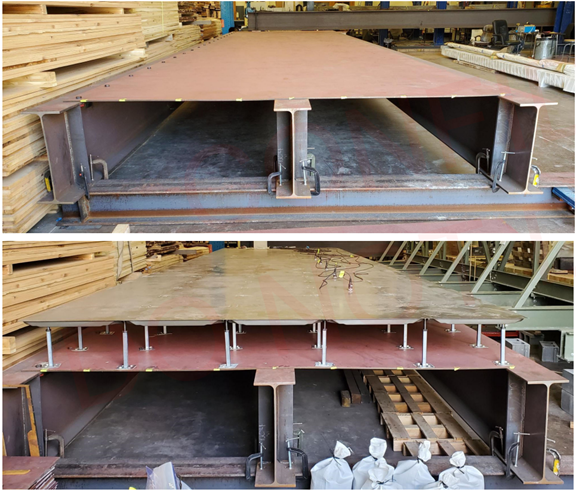
FastFloor Commercial specimen showing (top) the base module and (bottom) the module
with the raised floor installed. Photo courtesy of Onur Avci, PE, PhD.
